To maximize energy efficiency and sustainability in your home, consider these seven renewable energy solutions: solar panels, which offer significant savings on electricity bills; small wind turbines, effective in windy areas; biomass heating systems, utilizing organic materials for warmth; air source heat pumps, which efficiently heat homes even in cold temperatures; energy storage systems, like the Tesla Powerwall, for managing excess energy; hydroelectric power, harnessing water flow for reliable energy; and community renewable initiatives that promote shared investment. Each option presents unique advantages that can enhance your energy independence and reduce costs, leading to even more insights ahead.
Solar Energy Solutions
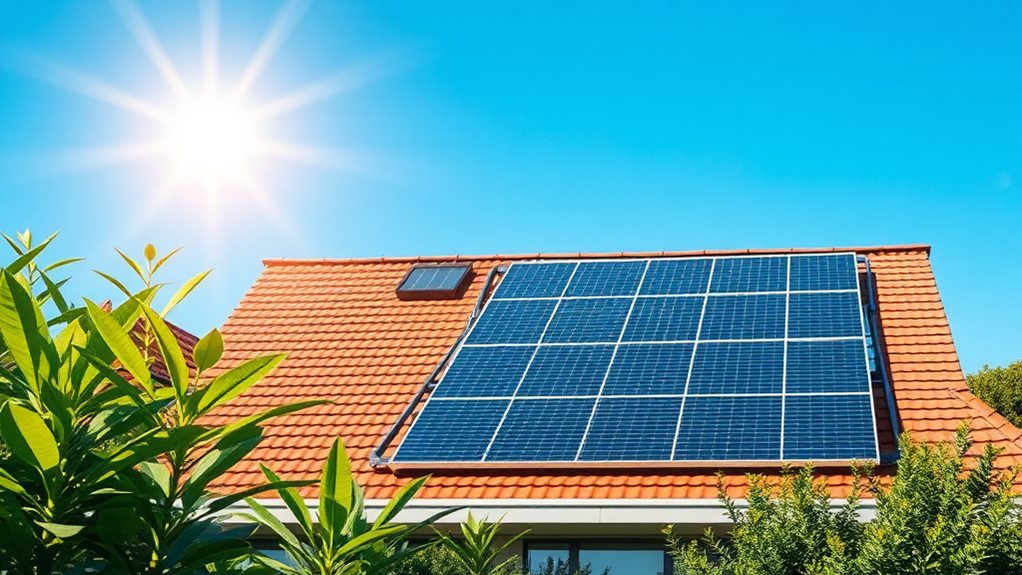
If you're looking to reduce your energy bills and embrace sustainability, solar energy solutions are a fantastic option for your home. By having solar panels installed, you can harness the power of the sun to generate approximately 10 watts per square foot, which can meet or even exceed the average American household's monthly energy consumption of about 900 kWh.
This means you could save an average of £904 annually on electricity bills. In addition, many homeowners can take advantage of solar energy tax credits that greatly lower installation costs. Additionally, any excess energy you produce can be sold back to the grid through the Smart Export Guarantee (SEG), providing you with additional financial benefits.
Beyond electricity generation, consider solar water heaters that can cut your domestic water heating bills by 50-80%. These systems come in both active and passive designs, ensuring you can find an option that suits your needs.
If you're seeking a smaller scale renewable energy solution, solar ovens can cook food using only sunlight, perfect for power outages.
Furthermore, solar air conditioning systems utilize solar-heated water for cooling indoor spaces, greatly decreasing electricity consumption. Embracing solar energy can transform your home into a more sustainable and cost-effective living environment.
Wind Energy Options
When considering wind energy options for your home, small wind turbines can offer an efficient and reliable source of electricity, especially in areas with consistent winds.
You'll want to assess your property's layout and local regulations to determine the best installation method, whether free-standing or rooftop-mounted.
With the potential for significant savings on energy bills and the opportunity to earn from excess energy, exploring these options could be a smart investment for your household.
Residential Wind Turbines
Residential wind turbines are an excellent way to harness clean energy right from your backyard. These systems can generate electricity through their wind-driven turbine blades, and even smaller models can provide substantial energy savings. For instance, a 6kW turbine can save you around £340 annually.
To guarantee you get the most out of your investment, it's vital to assess wind resources, as properly sized turbines typically require sustained winds of at least 10 MPH.
You have different installation options, including free-standing units or mounting them on buildings, both of which enhance your energy independence and reduce reliance on the grid. Additionally, you can earn extra income by selling any excess electricity back to the national grid through the Smart Export Guarantee (SEG), potentially adding approximately £235 to your annual savings.
While residential wind turbines can satisfy most of your electricity needs, it's important to take into account factors like noise, aesthetics, and local zoning regulations before installation.
Energy Generation Efficiency
Harnessing wind energy effectively hinges on understanding energy generation efficiency, particularly how factors like turbine size and height impact performance.
Small wind turbines can be a great option for your home, especially if you live in an area with consistent wind patterns. For effective power generation, these turbines typically require sustained winds of at least 10 MPH. A properly sized 6kW wind turbine can save you around £340 annually on electricity bills and potentially earn you an additional £235 per year from Smart Export Guarantee (SEG) payments for any excess energy generated.
The height of your wind turbine plays a critical role in its energy output. For instance, a 100-foot tower can generate up to 30% more energy than a 60-foot tower due to increased wind exposure at greater heights.
This makes wind power a stable renewable source, complementing solar energy and diversifying your home's energy portfolio, thereby enhancing your overall energy independence.
Installation Considerations and Regulations
Installing a small wind turbine at your home involves several important considerations, from site assessments to local regulations.
First, you'll need to conduct a thorough site assessment to evaluate wind resources and determine the ideal turbine placement. Sustained winds of at least 10 MPH are necessary for efficient energy generation, and taller turbines can greatly enhance energy output. For instance, a 100-foot tower can generate 30% more energy than a 60-foot one.
Before moving forward, check with local authorities regarding zoning regulations and permits. These local zoning regulations may dictate where and how you can install a wind turbine, focusing on factors like noise and aesthetics. Compliance is vital to avoid legal issues and potential fines.
Installation costs for small wind systems range from $65,000 to $95,000, a substantial investment, but the potential savings on electricity bills—approximately £340 annually—can offset these expenses over time.
Whether you choose a free-standing unit or a turbine mounted on your building, careful planning and adherence to regulations will guarantee a successful installation, harnessing wind energy effectively while respecting your community.
Biomass Heating Systems
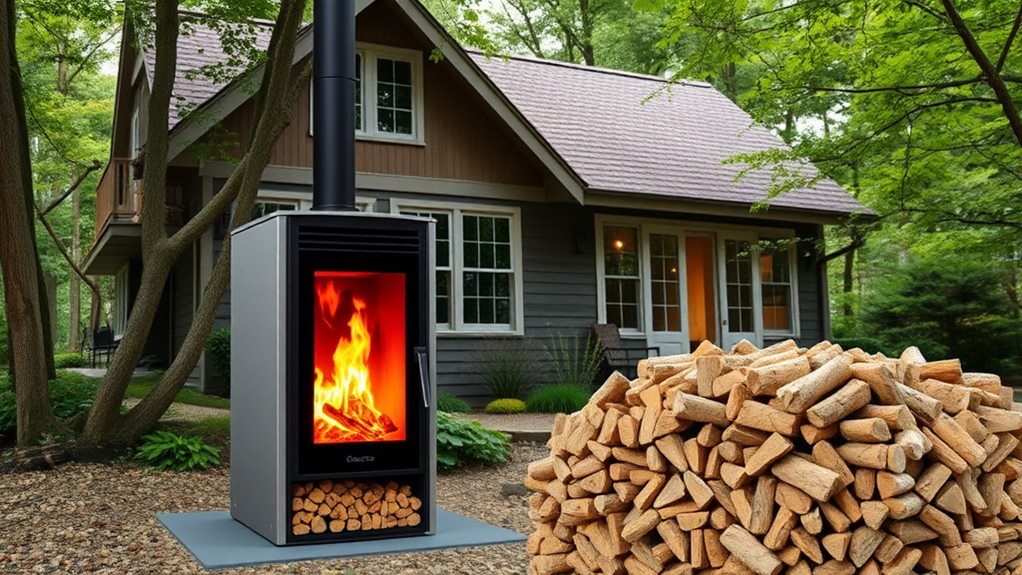
Biomass heating systems offer an eco-friendly alternative for your home, utilizing organic materials like wood pellets and chips to reduce carbon emissions.
By integrating these systems with your existing heating setup, you can enjoy significant cost savings—potentially up to £870 annually—while contributing to local economies.
As you explore the benefits and types of biomass systems, you'll find a sustainable option that aligns with your energy efficiency goals.
Benefits of Biomass Heating
When you consider energy solutions for your home, biomass heating systems stand out for their numerous benefits. One of the most notable advantages is the potential for considerable cost savings. By using organic materials like wood pellets, chips, or logs, you could save up to £870 annually compared to traditional electric heating systems. This not only improves your budget but also contributes to a more sustainable lifestyle.
Additionally, biomass systems achieve carbon neutrality. The carbon released during combustion is offset by the carbon absorbed by trees throughout their growth cycle, making them an environmentally friendly option. By choosing biomass heating, you're opting for renewable energy to power your home, greatly reducing greenhouse gas emissions throughout the system's lifecycle.
Moreover, the installation and operation of these systems can bolster local economies by creating jobs within the biomass supply chain and plant operations.
As advancements in biomass energy continue to develop, these systems are increasingly positioned to play a critical role in the UK's future heat and energy generation landscape. Embracing biomass heating not only benefits you financially but also contributes positively to the environment and your community.
Types of Biomass Systems
There are several types of biomass heating systems available to suit different needs and preferences. These systems primarily utilize organic materials such as wood pellets, chips, or logs to generate heat, making them an eco-friendly alternative to traditional fossil fuels.
One popular option is the wood stove, which offers a classic heating solution and can efficiently warm small to medium-sized spaces. Pellet stoves, on the other hand, provide a more automated approach, feeding pellets into a combustion chamber for consistent heat output.
If you're looking for a larger-scale solution, biomass boilers might be the best choice. They can produce hot water and heat for an entire home or even commercial buildings. Each type of biomass heating system has its own capacities and efficiencies, allowing you to select one that fits your specific heating needs.
One significant advantage of biomass heating systems is their ability to reduce carbon emissions. When these systems combust organic materials, the CO2 released is offset by the carbon absorbed during the growth of the biomass, achieving carbon neutrality.
Cost Savings Overview
Saving money on heating bills is one of the most appealing benefits of biomass heating systems. These systems can save you up to £870 annually compared to traditional electric heating options, making them a cost-effective choice for your space heating and hot water needs.
While the upfront costs of installing biomass systems can be higher than conventional methods, government support and incentives can considerably offset these expenses, enhancing their financial viability.
Moreover, using locally sourced biomass fuels, such as wood pellets or chips, not only contributes to your cost savings but also stimulates your local economy by creating jobs in biomass production and distribution.
The carbon neutrality of biomass energy further adds to its appeal, as trees absorb carbon during their growth, leading to lower overall emissions compared to fossil fuels.
As biomass systems are expected to supply up to 15% of the UK's heating needs by 2030, investing in this renewable energy solution not only benefits your wallet but also supports broader environmental goals.
Air Source Heat Pumps
Air source heat pumps (ASHPs) increasingly offer an efficient solution for heating and hot water in homes, even in chilly temperatures as low as -15°C.
These innovative heating systems draw warmth from outside air, providing a sustainable alternative to traditional fossil fuel heating methods. By operating on the principle of transferring heat rather than generating it, ASHPs achieve efficiencies that can exceed 300% under ideal conditions.
One of the most compelling reasons to evaluate ASHPs is their potential to save you money. Homeowners can save up to £1,330 annually compared to older electric storage heaters, which is a significant reduction in energy costs.
Additionally, the UK Government supports this shift by offering grants of up to £5,000 for the installation of air source heat pumps, making it more accessible for everyone.
Energy Storage Technologies
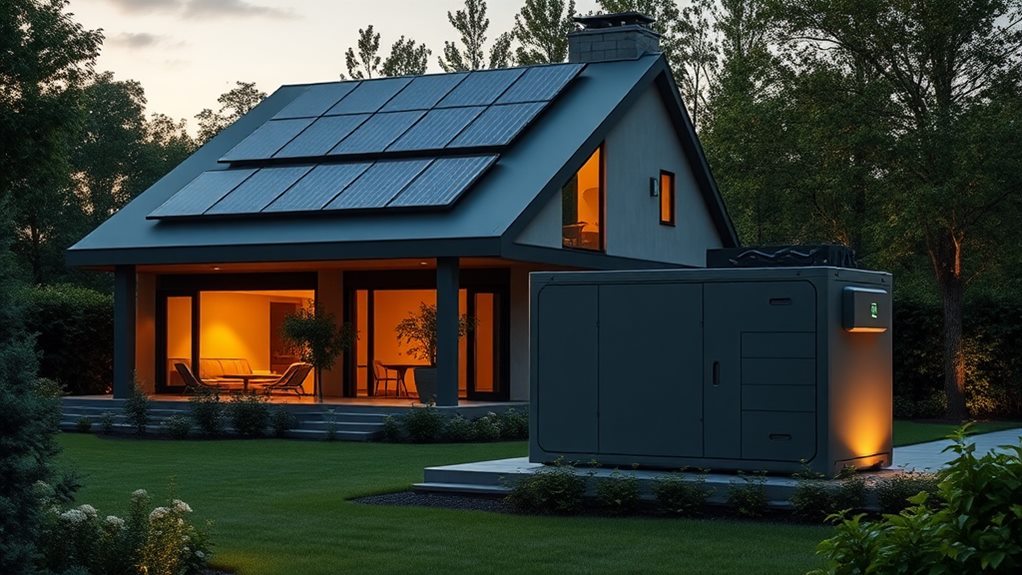
Energy storage technologies play an essential role in maximizing the benefits of renewable energy in your home. These systems, like battery storage solutions, allow you to store excess energy generated from sources such as solar and wind. This stored energy becomes invaluable during low production periods or outages, guaranteeing you have a reliable power supply when you need it most.
By investing in top-tier solar installation services, you can guarantee that your energy storage system is optimized for efficiency and tailored to your specific energy needs.
One popular option is the Tesla Powerwall, which can store several kilowatt-hours of electricity. By integrating such energy storage technologies, you facilitate energy independence and optimize your energy consumption patterns. This means you can utilize solar energy even after sunset, greatly reducing your reliance on the grid.
Moreover, battery storage systems enhance the efficiency of your renewable energy installations, addressing the intermittency issues often associated with solar and wind energy.
While the initial costs of home energy storage can vary, the long-term savings and benefits of achieving energy independence can outweigh these expenses over time. By investing in energy storage, you're not just enhancing your home's energy efficiency; you're also taking a considerable step towards a more sustainable and independent energy future.
Hydroelectric Power Systems
Hydroelectric power systems consistently provide a reliable source of electricity by harnessing the kinetic energy of flowing water. These systems are particularly efficient and can stabilize energy generation, especially in areas near rivers or streams.
By installing small-scale hydro systems on private property, you can generate your own renewable energy with a minimal water drop of just one meter. This means you have the potential to greatly reduce greenhouse gas emissions while enjoying the benefits of a consistent power supply.
While the initial setup costs typically range from $4,000 to $6,000, the long-term advantages often outweigh these expenses. Unlike solar or wind energy systems, which depend on weather conditions, hydroelectric power offers continuous energy generation year-round. This reliability makes it an attractive option for homeowners seeking sustainable solutions.
Before you proceed with installation, it's crucial to conduct an environmental impact assessment to guarantee compliance with local regulations and minimize ecological effects.
Community Renewable Initiatives
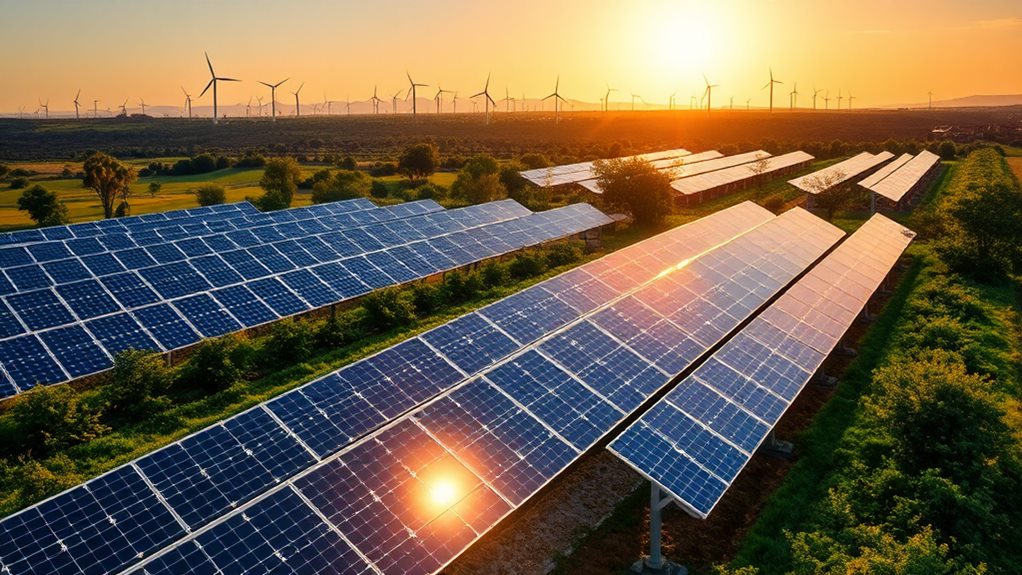
As homeowners explore various renewable energy options, community renewable initiatives are becoming an increasingly popular way to harness collective resources. These initiatives allow neighborhoods to invest together in renewable energy projects, like community solar programs, which enable participants to buy into a shared solar array. This is especially beneficial for those who can't install systems on their own properties, ensuring wider access to clean energy solutions.
In California, where solar energy accounts for approximately 20% of the state's electricity, solar energy growth is driving these community projects forward.
By engaging in collective purchasing agreements, you can considerably lower the costs associated with solar panels and wind turbines. These agreements foster a sense of community responsibility and promote local energy generation, making clean energy more accessible to everyone involved.
Furthermore, many community energy projects qualify for government grants and incentives, further reducing installation costs and enhancing financial viability for local groups.
Participating in these initiatives not only saves money but also encourages sustainable practices among residents, resulting in reduced overall energy consumption and lower carbon footprints.
Ultimately, community renewable initiatives serve as a powerful method for you and your neighbors to collaboratively embrace a sustainable future while enjoying the benefits of renewable energy together.
Final Thoughts
Incorporating renewable energy solutions into your home not only benefits the environment but can also save you money in the long run. While some may worry about the initial investment, consider that many options, like solar panels and energy storage, often pay for themselves over time through reduced energy bills and available incentives. By embracing these technologies, you're taking a significant step toward sustainability, enhancing your home's value, and contributing to a cleaner future for everyone.

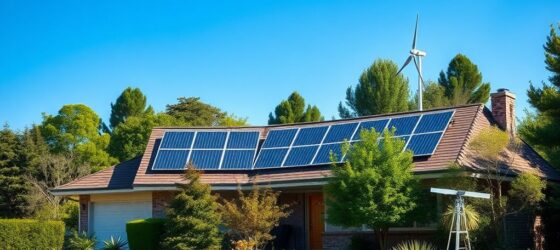
Recent Comments